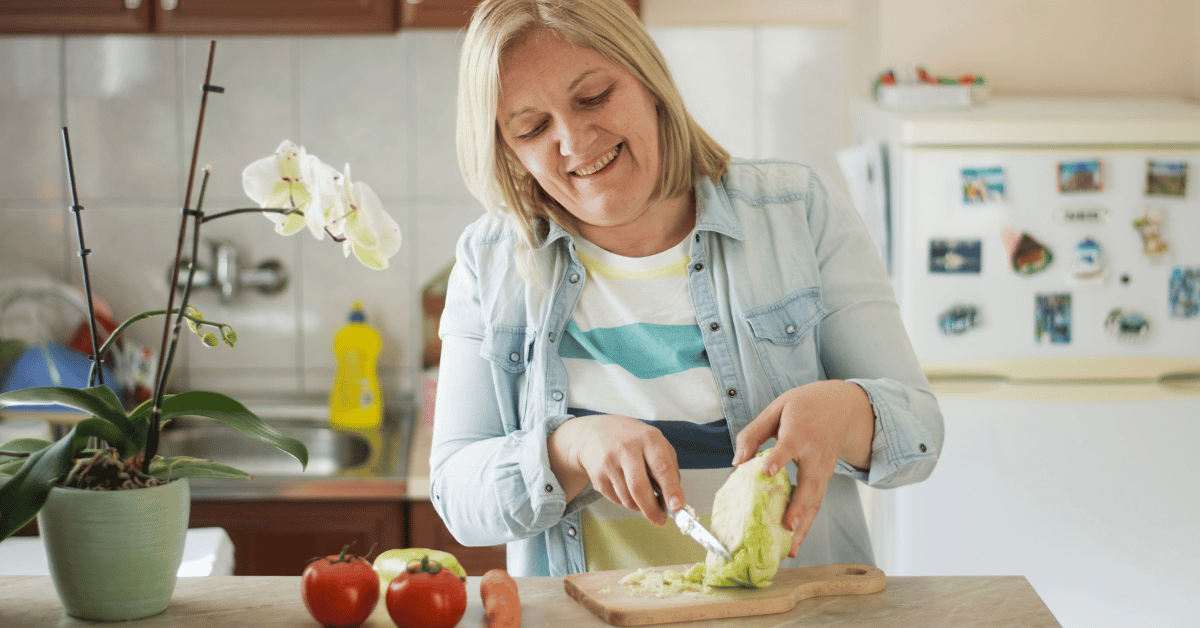Preparing your own meals can help you take charge of your health. Today, more and more of us
live alone, either by choice or circumstances and that means you are cooking for one. As a single person, finding the motivation to cook for yourself can be challenging and coming up with meal ideas for one person can seem like a chore.
Can Convenience Be Healthy?
Eating out, visiting the drive-through, or throwing a frozen dinner in the microwave can seem
like a much easier option. But eating convenience foods on a regular basis can take a toll on
your physical and mental health.
Fast food and TV dinners tend to be low in nutrition and high in unhealthy fats, sugar, sodium,
and calories. Often, for less money and only a little more time, you can create healthier, better
tasting meals yourself.
The key to cooking for one is to master a few basic skills, stock up on essential ingredients, and
get creative in making meals that work for you. Even if you don’t have access to a full kitchen,
you can still cook quick, inexpensive meals that not only taste great but also boost your energy,
stabilize your mood, and keep you as healthy as possible.
Benefits of Cooking For One
One of the easiest ways to improve your mental and physical health is by preparing more meals
at home. Cooking for yourself gives you greater control over the ingredients in your meals,
helping to cut down on additives and calories often loaded into takeout and convenience food.
Improving your diet with simple, healthy home-cooked meals can also help lower your risk for
serious illness, boost your energy, sharpen your mind, help manage your weight and improve
how you manage stress.
While all this is true of cooking at home for an entire family, there are specific benefits of
cooking just for yourself:
- You can eat whatever you want, whenever you want.
- Meals can be cooked faster.
- There is less waste and less cleanup.
- It can save you money.
- It’s empowering and allows for creativity.
Make it Social
Cooking for yourself doesn’t have to mean eating alone. With some creativity, you can prepare healthy, inexpensive meals at home, and still find that connection to others we all need.
- Cook a little extra and invite a friend or neighbor to join you in eating the meal. Everyone loves a home-cooked meal and most people who live alone are in the same boat as you. You can even share cooking responsibilities—one prepares the entrée, the other a salad. Or prepare a meal together and share leftovers. Cooking with others can be a fun way to try out new recipes and deepen relationships.
- Make your food at home, then eat out at a park or picnic area.
- Shop for food at a community or farmer’s market instead of a grocery store. People here are more likely to take the time to discuss the food and give cooking tips.
Getting Started
As you get started with more home prepared meals, keep these tips in mind.
- Think outside the box. Dinner doesn’t have to be a traditional meal of protein, starch, and vegetables. In fact, when you’re cooking just for yourself, dinner doesn’t have to mean traditional dinner foods at all. A breakfast of omelet, cheese, and veggies can also work as a healthy evening meal. Mix things up and cook using whatever combination of healthy ingredients you enjoy.
- Keep it simple. Cooking for one doesn’t have to be a huge time investment. A microwaved baked potato, filled with cheese or canned tuna, and served with steamed vegetables or a salad, makes a healthy, balanced meal that’s ready in minutes.
- Stock up on staples. With just a few staple ingredients you’ll be able to whip up a healthy meal quickly and easily. These include items such as canned tomatoes, beans, and tuna, frozen fruit and vegetables, dried herbs and spices, nuts, oil, vinegar, bouillon cubes, pasta, rice, and flour.
- Look for shortcuts. Buy pre-chopped and washed vegetables and salads can save time on meal prep and cleanup.
- Cook once, eat multiple times. Cook larger meals and freeze leftovers in single portions
- to eat another time.
- Prepare meals without cooking. Make a meal out of raw veggies or a salad, fruit add a no-cook protein like yogurt, cottage cheese, canned beans, tuna, or chicken.
- Cook your main protein once a week. By roasting a chicken on the weekend or slow cooking a turkey breast, you can use the leftover meat to quickly create different dishes during the week. Add the meat to a soup or salad, slice it in sandwiches, use in tacos, or quesadillas, or combine with veggies and add to pasta or rice.
- Reinvent leftovers. If you don’t want to eat the same meal a second time, having leftovers can be a great starting place for your next meal. For example, left over chicken can be transformed into chicken salad and served in a wrap with your favorite veggies. Or it can be chopped and added to a salad with tomato, cheese, salsa and avocado. You have a whole new meal!
- You don’t have to be perfect. Don’t feel that you have to start off by making every meal at home in order to reap the health benefits. Like anything, cooking for yourself is a habit that develops over time. Preparing home-cooked meals just a few times a week can improve how well you think and feel and encourage you to cook more often.

